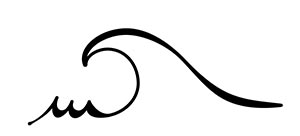
It is strange that no one ever asked me why I have chosen a wave as a logo for my tobacco pipes, and why I put a Lao Tzu aphorism on my website:
Each wave is aware to be the sea. What undoes it, doesn’t bother it because what breaks recreates. There may be two reasons for such indifference: it’s a detail of no interest, or it’s not a surprising thing to those who know me well. In either case, I want to take the opportunity (and the advantage of having my own website) to write two words on the subject, drawing, when necessary, information from Wikipedia and the “Treccani” encyclopedia.
For those who may not know, Lao Tzu (老子) was a Chinese philosopher in the 5th Century B.C. whose real name, dates of birth and death, and life are practically unknown. Lao Tzu is a nickname, which means “old” (lao, 老) “philosopher” or “master” (Tzu, 子). Lao Tzu is famous in China, Japan and more recently in Europe because of Tao Te ching, his only book of just over five thousand words, containing the elements of his philosophy.
Lao Tzu developed the concept of Tao, generally translated as The Path, whose significance is closely correlated to the cosmic nature of the universe: Nature is the Path. Lao Tzu also developed the concept of ‘effortless action’ (Wei Wuwei), which by no means encourages people to do nothing, but instead tells that we should refrain from having unattainable, egotistic, and strictly predetermined goals. Therefore, avoid action, not merely to escape the world and suppress all desire and passion (like Buddhists in India or mystics in the West, who renounce the world to reach divine contemplation), but simply to avoid restraining the natural manifestations of nature with artificial forms. Nature more easily reaches its expression when it’s not tortured by artificial boundaries and rules. Like many other ancient Chinese philosophers, Lao Tzu explained his ideas using paradoxes, analogies, old sayings, repetition, symmetry, rhymes and rhythm. Writings accredited to him are rich, poetic and represent a starting point for introspective and cosmological meditation.
Lao Tzu often used water as a metaphor, but not just waves.
Here is an example:
Here how we should be! Be like water.
No obstacles – water flows.
If it finds a dam, then it stops.
The dam breaks, water will flow again.
In a square recipient, water becomes square shaped.
In a round recipient, water becomes round shaped.
That is why water is more necessary than anything else.
Nothing exists in this world that is more adaptable than water.
Nevertheless, when water reaches the ground, persisting, nothing can be stronger.
After all of that, why did I choose a wave as a logo for my pipes and put Lao-tzu on a website about pipes? I do not know. Really. All I know is that one morning, without apparent reason, the Hokusai wave came into my mind. I then thought how it would be nice to manually reproduce the sinuosity of a wave movement on each pipe, simply using a poker for pyrography. In this way, I could obtain, not only a logo, which identifies its author and synthetizes his poetical vision, but at the same time, I could ensure the uniqueness of each wave, as it happens in nature.
I can try to intellectually find a relationship between the arising of the idea and its application, but the reality is that I simply, emotionally “felt” that there was something in that wave that connected with my work, but not only that. The Lao Tzu quote came afterwards, completing the picture and giving it coherence. A risky combination, a young Chinese student, to whom I was a mentor for her thesis on Italian wine and who later become a good friend, would tell me. It didn’t occur to me, at the time, that Chinese and Japanese don’t actually have an idyllic relationship. In fact, at this year’s Chicago Pipe Show I quivered when Mr. Feng asked to see my website, before becoming my official dealer for China. Will he be offended? – I asked myself. He was not, in fact, he really appreciated my site. And my pipes.




